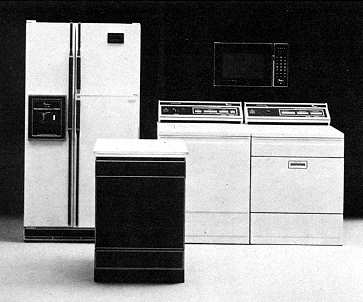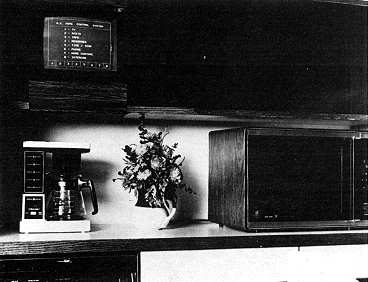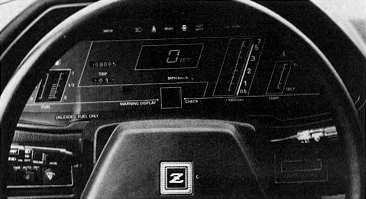SMART
PRODUCTS
Kathy Yakal, Editorial Assistant
PRODUCTS
Kathy Yakal, Editorial Assistant
All personal computers contain a microprocessor, the "brain" of the machine. But even if you don't own a computer, you probably have several of these tiny brains in your home, your office, or even your car. They are, in a sense, tiny computers.
Cars that act as their own mechanics. Cash registers trained to be marketing experts. Washer-dryers that take better care of your clothes than you could, and computers that guard your home. All of these "smart products" - products that can make decisions and monitor themselves - are no longer science fiction fantasy, thanks to the introduction of microprocessors in 1971.
A microprocessor is organized, compressed electronic circuitry which can execute programs and respond to changing conditions. It's about the size of your little fingernail and consists of a small silicon "chip" with complex patterns of lines etched on it.
Microprocessors replace circuitry many times their own size. For instance, if you take the back off a transistor radio, most of the components you see inside could be replaced with a single, small microprocessor.
There are several advantages to using this new technology in the production of consumer products. For one thing, because they are so much smaller than discrete (singular) circuits, products which house them can be much more compact. This is especially true of microcomputers, which wouldn't exist without them.
Microprocessors perform functions fast and precisely. They are easier to produce than discrete electronics and they don't wear out as quickly, since they have no moving parts. Most important, they are intelligent. They can be programmed to make decisions based on predefined conditions.
The Consumer Market
You can identify a consumer product that contains a microprocessor. There are generally no dials to turn or buttons to push or timers to set. Quite often there will be a flat membrane-type control panel that is responsive to the slightest touch. And you may be able to tell if the product contains a microprocessor by the type of input required from you (for example, instead of indicating how long you want your clothes to dry, you would only need to indicate the fabric type - the microprocessor would know how long and how hot to run).
Manufacturers of consumer products don't automatically use microprocessors in every product they could. The same technology that brought microprocessors into being also facilitated better design of microelectronic circuits; each has its own place. Further, some manufacturers are holding back to gauge public acceptance of the new breed of consumer products. This is critical: it's possible to make a washing machine that talks, but do people want that?
In the following product descriptions, we have chosen a few manufacturers which are representative of several industries. These companies are not the only ones using microprocessors. Also, these companies do not use microprocessors in all of their product lines. What we are looking at is still a state-of-the-art technology.
Self-monitoring
First let's explore some home appliances that use microprocessors. Refrigerators have been able to monitor themselves for a long time. You set the temperature level desired, and the unit shuts off upon reaching it.
The Whirlpool Corporation makes refrigerators that do even more. They beep if the door is left ajar. They let you know when the coils need dusting, or if there is a problem with the temperature inside, or if there is anything going on which will keep the machine from doing its best job of keeping food fresh.

Whirlpool uses microprocessors in the design of many home
appliances for more efficient operation.
Some microwave and toaster ovens use microprocessors. The purpose of these appliances is to cook food, and microprocessors are employed to do that better and faster. Whirlpool has some microwaves that will monitor food temperature so that it won't be overcooked, and will time several dishes so they are ready at the same time. Digital clock functions are built in.
Washing machines and dryers are more efficient when microprocessors are monitoring their functions. Some of the newer Whirlpool washers do not require you to choose a setting; if you just turn them on, they will go into a standard warm wash-cold rinse cycle. If you want to give additional information about the fabric you're washing, there is a flat membrane panel about a foot long listing your choices. If you make a choice that could damage your clothes, like selecting "knits" along with "hot water," the washer will let you know that this could be a mistake. It will make a low "boop" sound when something's wrong, a high "beep" when everything's all right.
Dryers also use microprocessors to determine the safest way for fabrics to dry. You select the fabric type, and the machine decides how hot the dryer should be and even how long it should dry (unless you set the manual timer). It also automatically fluffs the clothes at five-minute intervals to keep them from wrinkling.
Sony uses microprocessors in virtually all of its home entertainment components. The most common use in television sets is in the channel changer. Instead of a standard dial, many television sets now have a push-button control with a digital display; you can turn the television off or on, choose the channel (either by entering the number or scanning up and down), and adjust the picture by pressing some buttons. Increasingly popular remote control features are also made possible by microprocessors.
Tape players, stereo receivers, and turntables are also making increasing use of microprocessors. A variety of search, memory, and automatic play features can now be controlled by them.
Possibly the most sophisticated use of microprocessors in home entertainment systems is to be found in video cassette recorders. Virtually all of their working parts use them because the requirement for accuracy is so great.
Streamlining Daily Routines
Running a household may be simplified in the future because of these advances in electronic technology. General Electric has found a way to make it even easier with their "Homenet," a computer-based home automation system. Controlled by a video screen and keypad, the system allows control and monitoring of heating and air conditioning, security and fire systems, lights, appliances, and entertainment components. It uses existing house wiring and electrical current to send signals to appliances. Consequently, the system is compatible with any brand of home appliance.
Built-in telephone circuits allow complete access to the system by phone, so you can call your "Homenet" and tell it what time to start dinner or the washing machine, or to change any earlier instructions. The phone capabilities also enable a home security system, so that if your smoke or burglar alarm goes off, the computer is alerted to call the police, the fire department, or a neighbor.

The GE "Homenet," a home automation system, lets you
control household appliances, entertainment components,
and security systems through one central keypad and video
screen.
The "Homenet," of course, uses microprocessors in its computer unit. It is possible to use your own home computer to set up such a system, but this can require a fairly sophisticated understanding of computers and interfacing.
Electronic Motoring
The use of microprocessors in automotive electronics is expanding rapidly, according to a representative of the Nissan Corporation. Some of Nissan's top-of-the-line cars (for example, the turbocharged ZX) use microprocessors, especially in engine control. All fuel injection functions are digitalized; that is, everything necessary for getting gasoline into the engine efficiently is computed. Fuel economy is constantly monitored based on current conditions, so if you're going into a headwind, the computer tells you how long your fuel will last if the wind keeps up.
Microprocessors measure and correct the EGR standard. The audio warning system - the ability of the car to say "Your door is open" or "Fuel is low" - is prioritized. The microprocessor decides which condition is more critical, and warns you of that one first. This is where microprocessors are clearly revealed as a technological leap: they can make intelligent decisions. The most visible use of microprocessors in Nissan cars, however, may be in the scanning and memory capabilities of the digitally tuned AM/FM radio.

The digital instrument display of this 1983 Datsun 280ZX
illustrates the numerous features now controlled by micro-
processors in cars.
Nissan has some more exotic uses planned for microprocessors in its 1984 models. One of these, the "knock sensor," will adjust the spark advance to help prevent the "pinging" created by low-octane fuel.
The Ford Motor Company says that its 1983 Lincoln Continental is the best example of the new electronic technology in the company. Microprocessors are used for five different functions in this car: in the radio-electronic cassette; the electronic "instrument cluster"; the "trip minder" (a trip computer that calculates time, engine functions, etc., when you're driving a long way); a keyless entry system (a panel of five push buttons on the outside of the driver's door that requires certain entry codes to lock and unlock the car doors and trunk); and the EEC IV Electronic Engine Control System, a fourth-generation engine-control system developed jointly by Ford and Intel using a 16-bit microprocessor.
Additional computerized functions you may see on the 1984 Ford models include a digital thermometer (for outside temperature); digital temperature control; a digital fuel gauge; and electronic air suspension (springs replaced by air bags using a height sensor).
Increased Business Efficiency
All of these products utilize technologies that now exist (or soon will) in your home or garage. But businessmen have not ignored microprocessorbased technology either. The chips will also have a dramatic effect on ordinary commercial transactions.
It's becoming common these days to go to the grocery store and have your purchases rung up by a clerk who barely touches any keys on the cash register. This "price look-up file" goes one step further: the item being scanned shows up on a digital display with its name and price. You then get a printout of what you bought and what it cost. This is all accomplished by National Cash Register (NCR) through the use of microprocessors.
Information gathered by such accounting is not just useful to the customer and a time-saver for the clerk. Marketing experts can use the data to tell if, for instance, a person who buys a certain brand of toothpaste also buys baby food or exotic hors d'oeuvres or cigarettes. In that way, they can get a better idea of what market should be targeted for their advertising. Store managers also use the information to gauge the effectiveness of store displays, shelf height, or their own advertising.
Replacing People
You may already be accustomed to banking at an "instant cash machine." Though used to a degree for about ten years, the machines have gained real public acceptance only in the last couple of years, says a representative of NCR. The same kind of microprocessor-based technology found in these machines may also put computer terminals in places where you're accustomed to seeing people: at gas stations, in hotel lobbies, and at airports.
This is not to say that computers will completely replace clerks within the decade. But NCR will be introducing self-service terminals to streamline certain businesses. At a gas station, you may be able to put your credit card in a slot, enter your secret code and the amount and kind of gasoline you want, and the computer inside would dispense the gas and charge it to your account.
In a hotel lobby, you could have the option of confirming your reservation and getting your room assignment from a terminal in the lobby.
This terminal would interface with the guest accounting system that is already in use in many hotels, to provide you with a computerized, bill at check-out time.
Terminals programmed with flight information may begin to appear in shopping malls and other convenient locations soon. You will be able to get flight information and make reservations on these; then, when you arrive at the airport for your flight, another terminal will check you in and give you your ticket and boarding pass.
The Invasion Of Intelligence
However, for all of the seeming inevitability of the invasion of microprocessor intelligence into our daily lives, it's not entirely beyond question or modification. Manufacturers of consumer products are watching public reaction to these new inventions closely. The technology is there. What remains to be seen is how people will feel about the new smart machines.